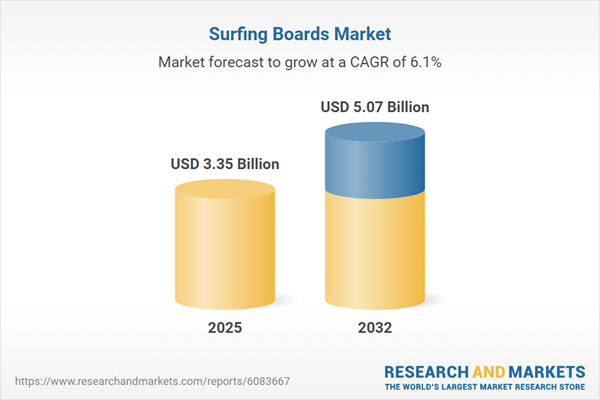Speak directly to the analyst to clarify any post sales queries you may have.
The surfing boards market is entering a dynamic phase, shaped by ongoing material innovation, shifting consumer preferences, and advances in digital and distribution channels. Companies that adapt their strategies to these changes are better equipped to capture evolving opportunities and secure resilience in a competitive landscape.
Market Snapshot: Surfing Boards Market Size and Growth Trajectory
The surfing boards market grew from USD 3.16 billion in 2024 to USD 3.35 billion in 2025. It is projected to expand at a CAGR of 6.08%, ultimately reaching USD 5.07 billion by 2032. This growth is driven by innovation in board materials, expansion of e-commerce, and rising participation across emerging and established surf destinations.
Scope & Segmentation: Key Dimensions Shaping the Surfing Boards Market
- Board Types: Fish, funboard, longboard, shortboard, soft top, and stand up paddle models each address specific performance needs and rider levels.
- Distribution Channels: E-commerce, general retailers, and specialty stores deliver a mix of accessibility, guided expertise, and product customization.
- Material Types: Epoxy—including carbon epoxy and E-glass epoxy—enhances responsiveness and durability; inflatable options leverage drop stitch and hybrid architectures for portability; traditional polyester models use fiberglass or PU resin for established performance and cost sensitivity.
- Skill Levels: Beginner, intermediate, and professional categories inform design attributes and marketing strategies for brands targeting different segments.
- End Uses: Competitive, recreational, and rental or school programs diversify demand and influence inventory management as well as product design.
- Wave Types: All-around, beach break, point break, and reef break specifications ensure boards meet the needs of varied surf conditions and geographies.
- Regional Scope: The Americas, Europe, Middle East & Africa, and Asia-Pacific regions present unique growth drivers, infrastructure, and consumer priorities. Sub-regions include North America, Latin America, Europe, the Middle East, Africa, and Asia-Pacific countries spanning from China to Australia.
- Key Players: The competitive ecosystem includes established manufacturers such as Global Surf Industries, Channel Islands Surfboards, Firewire Surfboards, Lost Enterprises, Boardworks Hawaii, JS Industries, New Surf Project, HaydenShapes, Torq Surfboards, and Tahe Outdoors Group.
Key Takeaways for Decision-Makers
- Sustainable materials—such as bio-resins and recycled foam—are gaining prominence, reflecting greater consumer and regulatory focus on environmental stewardship.
- Digital customization and immersive e-commerce are setting new expectations for purchasing, enabling personalisation and reducing reliance on physical storefronts.
- Product portfolios must span from advanced, performance-driven models to accessible, entry-level soft tops to attract a widening base of surf enthusiasts.
- Regional manufacturing partnerships and innovative inventory practices are emerging as effective responses to supply chain disruptions and regulatory changes.
- Strategic alliances between established brands, startups, and technology providers are accelerating R&D, supporting hybrid board innovations, and optimizing delivery networks.
Tariff Impact: Navigating Shifts in U.S. Trade Policy
Recent U.S. tariffs on imported surfing boards have heightened sourcing costs, causing some brands to explore nearshoring solutions, partner with local suppliers, and invest in regional tooling capabilities. These changes highlight the necessity of agile vendor management, cost optimization, and robust risk mitigation strategies for market participants.
Methodology & Data Sources
This report draws on primary interviews with industry executives, product designers, supply chain specialists, and professional surfers, complemented by surveys across retail, e-commerce, and user groups. Secondary research included analysis of industry publications, association reports, technical journals, patent filings, and strategic disclosures to triangulate findings and validate market patterns.
Why This Report Matters
- Enables senior leaders to benchmark their strategies against current innovation, sustainability, and shifting consumer behaviors.
- Informs supply chain and distribution planning by highlighting regional nuances and evolving fulfillment models.
- Equips organizations to anticipate the impact of trade policy changes and adapt resource allocation accordingly.
Conclusion
Organizations that prioritize sustainable practices, digital engagement, and flexible supply chains are well positioned to navigate ongoing industry shifts. Strong partnerships and adaptive strategies will be critical for capturing future growth and maintaining market relevance.
Table of Contents
3. Executive Summary
4. Market Overview
7. Cumulative Impact of Artificial Intelligence 2025
List of Figures
Samples

LOADING...
Companies Mentioned
The key companies profiled in this Surfing Boards market report include:- Global Surf Industries, Inc.
- Channel Islands Surfboards, LLC
- Firewire Surfboards, Inc.
- Lost Enterprises, Inc.
- Boardworks Hawaii, LLC
- JS Industries Pty Ltd
- New Surf Project Pty Ltd
- HaydenShapes Pty Ltd
- Torq Surfboards Ltd
- Tahe Outdoors Group S.A.
Table Information
| Report Attribute | Details |
|---|---|
| No. of Pages | 197 |
| Published | October 2025 |
| Forecast Period | 2025 - 2032 |
| Estimated Market Value ( USD | $ 3.35 Billion |
| Forecasted Market Value ( USD | $ 5.07 Billion |
| Compound Annual Growth Rate | 6.0% |
| Regions Covered | Global |
| No. of Companies Mentioned | 11 |









